Abstract
Copper-clad aluminum rods are usually fabricated using hydrostatic extrusion, since during direct and indirect extrusion fracture of the copper sleeve is difficult to avoid. In this study, different die surface topographies and lubrication conditions were applied to improve the material flow during indirect extrusion of copper-clad aluminum rods. Thus, conic dies with different roughness (polished and sandblasted) and surfaces shapes (fine and coarse grooves) were tested. Additionally, the effects of a wax-graphite-based lubricant as well as a graphite-like carbon (GLC) coating of the die conic surfaces were investigated. The composite billets were made of aluminum EN AW-1080A cores and copper CW004A sleeves with an equivalent copper cross section of 0.24 of the total billet cross section. For all trials, an extrusion ratio of 14.8:1 and a conic die angle of 2α = 90° were chosen. Non-isothermal extrusion trials were carried out using a container at 330 °C and billet and tools at room temperature to reduce the flow stress ratio σCu/σAl. The extruded composite rods’ integrity, surface quality, interface integrity, and equivalent copper cross section were analyzed. In addition, a visual inspection of the sleeve-die contact surface was performed. The results showed that the GLC coating proved to be unsuitable due to a lack of lubrication, which causes accumulated sleeve fractures and longitudinal grooves on the extruded rods. The best results were achieved with the combination of the sandblasted die surface and the wax-graphite-based lubricant, observing a uniform material flow without sleeve fractures.
1. Introduction
Copper-clad aluminum (CCA) composites are characterized by high conductivity and low contact resistance as well as lower weight and costs than a profile with the same cross section of solid copper. A low equivalent copper cross section of 0.10–0.30 of the total product cross section allows a reduction in costs and weight up to 40% and 60%, respectively. Therefore, CCA is used as bus bars and wires in industrial installations and automotive engineering. Usually, CCA is produced by hydrostatic extrusion, where the extrusion pressure is transmitted by a hydrostatic medium. This is a complex and costly process mainly because of high requirements for the sealing of the container due to high extrusion pressures. One advantage of the hydrostatic extrusion is the negligibly low fluid friction acting on the billets surface, which allows the sound extrusion of CCA products. These friction conditions are difficult to replicate in the conventional processes of direct and indirect extrusion, which causes product defects like inhomogeneous sleeve thickness or sleeve fractures. Hence, a manifold of publications investigated the extrudability of CCA by means of direct and indirect extrusion. The differences between direct and indirect extrusion and the influence of different lubricants regarding the fracture strain of the sleeve material were studied by Kang and Kwon with finite element analysis and experimental investigations. They found better quality of the extruded CCA rods by means of indirect extrusion []. Luo et al. investigated the cold direct extrusion process on very short billets with a length to diameter ratio of 2:1. They observed the formation of a full aluminum head and accumulation of copper in the die cone due to an unfavorable material flow at extrusion ratios and semi die angles higher than 5.45:1 and 15°, respectively []. Kang et al. also subjected the influence of extrusion ratio on the extrudability to their research. They presented better extrudability with lower extrusion ratios due to lower strain rate differences between the core and sleeve for both direct and indirect hot extrusion and a semi die angle of 30° []. These necessary low extrusion ratios and die angles make the direct extrusion process inefficient for the production of CCA rods because large extrusion discards and only short rods are produced. Kazanowski et al. investigated the geometric stability of the extruded composite rods and the formation of a full material head during direct extrusion. They suggested modification of the initial billet configuration by shortening the core to improve the material flow and prevent the extrusion of a full material head []. Haghighat and Momeni-Khabisi discussed the influence of the friction factor and extrusion ratio on the optimal semi die angle to obtain low extrusion forces in indirect extrusion by analytical and numerical calculations. They found an increase of the optimal semi die angles with an increase of the extrusion ratio and friction factor []. Kwon et al. showed a stable indirect extrusion process with an extrusion ratio of up to 21.4:1, a semi die angle of 30°, and a length to diameter ratio of approximately 3:1 for the billet. Moreover, they identified a maximum billet temperature of 300–350 °C for a sound composite extrusion of CCA under given conditions. At higher temperatures, an increased occurrence of sleeve fractures was observed and the difference in flow stresses between sleeve and core material was named as a cause []. Kang and Kwon also correlated the prevailing friction conditions during the extrusion with the occurrence of sleeve fracture and the quality of the extruded product. They used a carbon oil spray and a boron-nitride spray as lubricant and determined better material flow for the use of carbon oil spray by comparing the sleeve integrity of the extruded rods [].
In the present study, the indirect extrusion process was modified to improve friction conditions and, thus, prevent sleeve fracture during extrusion of CCA rods. By applying different surface topographies and lubricants on the die cone, and, thereby, creating lubricant reservoirs for a continuous supply with lubricant, suitable friction conditions for a sound extrusion should be achieved. A set of dies with polished die cone, as commonly used in extrusion, was used for reference. For the process conditions, a comparatively large semi die angle of 45°, moderate extrusion ratio of 14.8:1, and length-to-diameter ratio of 3.3:1 for the billet were chosen. Since the composite clad extrusion is prone to deviations in sleeve thickness, the equivalent copper cross section was measured in periodic intervals by means of digital image processing and analysis of metallographic cross sections. Moreover, these cross sections were subjected to a dye penetration test to characterize the interface integrity.
2. Experimental Procedure
2.1. Extrusion Trials
Indirect extrusion experiments were carried out on a 0.5 MN vertical extrusion machine (MAN AG, Ausgsburg/Nürnberg, Germany). The container that was 30 mm in diameter was heated to 330 °C using the integrated heating cartridges and temperature control unit. The heating rate was 100 °C/h and temperature was stabilized at target temperature for two hours. Billet, die, punch, and hollow stem were kept at room temperature. Due to the increasing flow stress ratio of aluminum and copper at higher temperatures, shown by Berski et al. [], non-isothermal process conditions with a hot container as well as cold billet and tools were chosen. According to the observations of Kwon et al., a lower flow stress ratio is beneficial for the successful extrusion of CCA rods []. Therefore, the non-isothermal setup was chosen to cause softening of the copper sleeve while the aluminum core stays relatively cold and, thus, relatively hard, which enhances the flow of copper. The strain-stress curves, provided by Sanabria et al., reveal a low strain rate sensitivity for both copper CW004A and aluminum EN AW-1080A []. Therefore, no significant influence of extrusion speed was expected and a moderate ram speed of 5 mm/s was chosen. In various publications dealing with CCA extrusion, low extrusion ratios between 2–10:1 were applied. For example, Berski et al. varied the extrusion ratio from 2–10:1 [], Kang et al. experimented with 7:1 and 8.8:1 [], and Luo et al. used extrusion ratios of 5.5:1 and 9:1 for their study []. Kwon et al. were able to achieve the extrusion of a sound CCA rod with a comparatively high extrusion ratio of 21.4 []. Regarding economic viability of the CCA production by means of indirect extrusion, a moderate extrusion ratio of 14.8:1 was chosen for this study. Thereby, the amount of scrap material (chips during billet preparation, nose crop, and extrusion discard) compared to the overall length of CCA rod per extrusion cycle is reduced. For a similar reason, a semi die angle of 45° was selected for the die configuration. Although a low semi die angle (15–30°) is beneficial for material flow and extrusion force during clad composite extrusion [,], this implies long and high-volume extrusion discards and, therefore, reduced turnout. Extrusion force and profile temperature were measured with an integrated load cell and thermocouples in the bearing channel, respectively.
2.2. Billet Assembly
The billet configuration used for all extrusion trials was a combination of a sleeve manufactured from an extruded and annealed CW004A copper tube and an extruded EN AW-1080A aluminum core (Figure 1A,B). The chemical composition of both materials is listed in Table 1. To achieve the largest possible quasi-steady 100 mm and 26 mm, respectively. In addition, the cores were prepared with a chamfer (4 × 45) and a centered hole (Ø 6.3 mm × 16 mm) at the front, as depicted in Figure 1C. The aluminum cores were made 5 mm shorter than the sleeves and geometrically modified to improve the material flow during the unsteady beginning of the extrusion process and to reduce the length of the full aluminum head, according to Kazanowski et al. []. Sleeves and cores were degreased with soap and ethanol before being joined by shrink fitting with liquid nitrogen. After joining the diameter of the composite, billets were machined to 29.8 mm. The resulting sleeve thickness was 1.9 mm and the equivalent cross sections were 0.76 for aluminum and 0.24 for copper. Furthermore, the front end of the copper sleeve was flanged to 9° (Figure 1C).
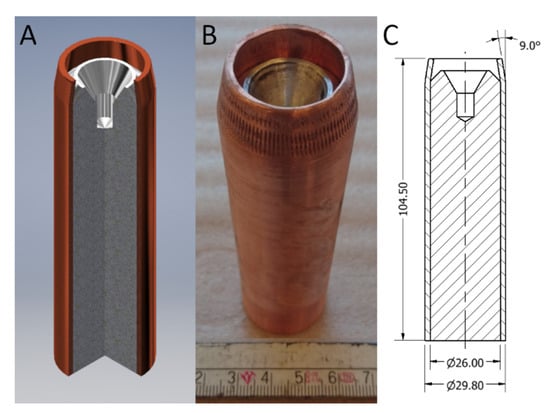
Figure 1.
(A) digital 3D model, (B) photograph, and (C) drawing of the manufactured billets.

Table 1.
Chemical composition of copper CW004A and aluminum EN AW-1080A [,].
2.3. Die Configuration and Lubrication Conditions
Conical dies with a semi die angle of 45° were used for all extrusion trials. The diameter and length of the bearing channel were 7.8 mm and 4 mm, respectively. In order to investigate the influence of die surface topography on the indirect extrusion process, different roughness and surfaces shapes were tested. Thus, dies with four different surface topographies were produced: polished, sandblasted, fine and coarse concentric grooves (Figure 2A). Polishing was carried out with P120 fleece. For the sandblasting normal corundum with a grain size of 60–120 µm and a pressure of 9.5 bar were applied. To prevent roughening of the bearing channel during the sandblasting, a customized plug was used. Fine and coarse concentric grooves were carefully turned on the conic die face. In combination with the surface topography, two lubrication conditions were tested. On the one hand, the previously mentioned four different conic surfaces were covered with a wax-graphite-based standard lubricant for hot extrusion (Luprit SP 19) by preheating the dies and applying the lubricant. Luprit SP 19 is the trade name of a mixture of polyethylenes (approximately 70 wt.%) and graphites (approximately 30 wt.%) for the extrusion process of non-ferrous metals at elevated temperatures with a drop point of approximately 80 °C. On the other hand, another set of four dies with the same four surface topographies was coated with an approximately 6 µm thick graphite-like carbon (GLC) layer via magnetron sputtering, which is a physical vapor deposition (PVD) process (Figure 2B). GLC is characterized by a low friction coefficient and low wear rate []. The motivation for using a second kind of lubricant was the possibility to reduce the probability of over-lubrication and increase process efficiency by applying a very thin coat of durable lubricant. Over-lubrication can leave large amounts of lubricant on the extruded product or even cause surface defects on the product and, therefore, has to be avoided. Process efficiency can be improved by using a lubricant, which provides good lubrication for several process cycles and does not have to be applied between every cycle. It is also important to mention that the container liner was lubricated with Luprit SP 19 for all trials.
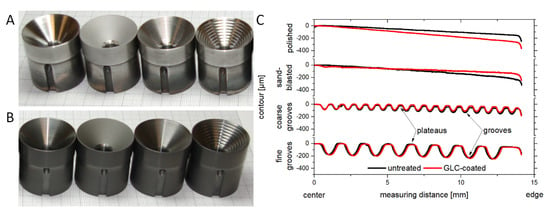
Figure 2.
Dies with different cone surfaces. (A) Untreated, f.l.t.r. polished, sandblasted, fine grooves, coarse grooves. (B) graphite-like carbon-(GLC)-coated, f.l.t.r. polished, sandblasted, fine grooves, coarse grooves. (C) Measured surface contours.
Moreover, the contour of each die was measured with a Waveline T8000RC stylus profilometer and the probing system TKU 300 (Hommel-Etamic GmbH, Jena, Germany). The measured contours are illustrated in Figure 2C. Measurements showed an average roughness of Ra = 0.105 µm for the polished surfaces and Ra = 0.795 µm for the sandblasted surfaces. Average groove depth, distance, and width for fine and coarse grooves are 80 µm, 798 µm, 550 µm and 187 µm, 1590 µm 110 µm, respectively.
3. Results
3.1. Extrusion Trials
A total of eight trials with four different die cone topographies and two different lubrication conditions were performed (Table 2). The extrusion diagram of trial No. 1, together with selected parts of the extruded composite rod, are shown in Figure 3. The course of the extrusion force corresponds to the standard extrusion practice by applying a polished die cone and Luprit SP 19 as lubricant during indirect extrusion. The graph first displays the typical course of this particular extrusion condition. This is a load peak at the beginning, which is followed by a constant extrusion force in the quasi-steady state. However, there are also periodic oscillations with a steady increase of the extrusion force at the last 30 mm of stroke. The comparison of force evolution and the extruded rod reveals a clear relationship between the characteristic features of the force curve and the sleeve integrity. Thus, a sound composite extrusion is obtained during the quasi-steady state (stroke 25 mm to 60 mm), but sleeve fractures occur during the force oscillations. The tip of the rod shows a small full aluminum head of approximately 8 mm in length.

Table 2.
List of trials with different die cone topographies and lubricants.
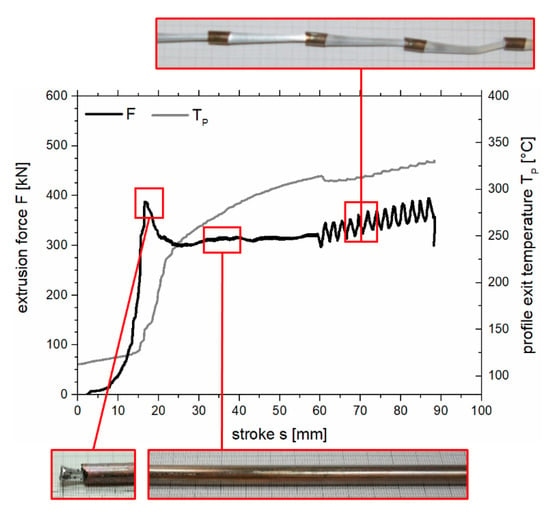
Figure 3.
Extrusion diagram and selected parts of the extruded composite rod of trial No. 1.
The load-stroke curves of trials No. 1–4 with Luprit SP 19 as lubricant are shown in Figure 4A. All of them display a similar course, which is typical for the indirect extrusion process. The observed oscillations in the load-stroke curve also occur at trial No. 3 and No. 4 shortly after the force maximum and close to the end of trial No. 3. Considering the maximum force, a trend proportional to the smoothness of topography is visible. As the smoothness of topography decreases, the maximum force increases. In the quasi-steady state, a proportionality of decreasing extrusion force with decreasing smoothness topography can be observed.

Figure 4.
Extrusion diagrams of trials No. 1–4 lubricated with Luprit SP 19: (A) load-stroke curves and (B) temperature-stroke curves.
Regarding the profile exit temperature, this increases slightly in the first stage of the extrusion due to the contact of cold die with the hot container (Figure 4B). After a rapid rise, the temperature approaches asymptotically to a constant value between 310 °C and 340 °C. When comparing the temperature increase from the beginning of the extrusion to the temperature at a stroke of 60 mm, the increase is the highest for the sandblasted tool and the lowest for the tool with coarse grooves. Furthermore, it should be noted that, at the same time, as the oscillations of the extrusion force occur, a stepwise increase of the temperature is seen.
The extrusion trials No. 5–8 were carried out on conic dies with different topographies (polished, sandblasted, fine grooves, and coarse grooves) and coated with GLC (Figure 2B). During these trials, the extrusion press reached its maximum load capacity (525 kN), producing safety shutdowns of the hydraulic pump and, therefore, force drops to zero. Figure 5 shows the load-stroke curve of trial No. 7, where the force drops due to safety shutdowns can be seen. To improve the clarity of the graphic image, these partially recurring force drops were cut out in Figure 6A, which illustrates the load-stroke curves of trials No. 5–8. Trial No. 5 with the polished die shows a very similar course to trial No. 1, but there is a large drop of the extrusion force following the maximum. The curves of trials No. 6–8 differ significantly from the typical course of indirect extrusion. They are characterized by a more or less distinctive plateau before the force maximum is reached. The extent of these plateaus correlates with the die cone topography and increases with decreasing smoothness of topography. The trend of a decreasing quasi-steady state extrusion force with decreasing smoothness of topography can also be seen here. Similar to trials No. 1–4, the temperature curves in Figure 6B show an initial slight increase, which is followed by a steep rise and approach to a constant value between 310 °C and 370 °C. These curves were also cleared from oscillations caused by the safety shutdowns in the range of a stroke of 20–40 mm. Again, the stepwise increase of the profile exit temperature is synchronized with the oscillations or drops of the extrusion force. The lowest and highest increase of temperature is measured for the dies with coarse grooves and sandblasted topography, respectively.
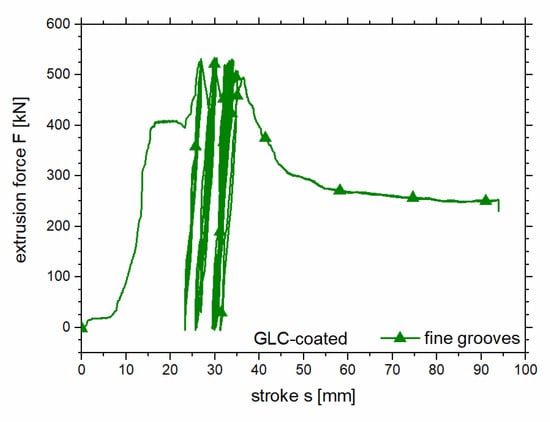
Figure 5.
Load-stroke curve of trial No. 7 with safety shutdowns.
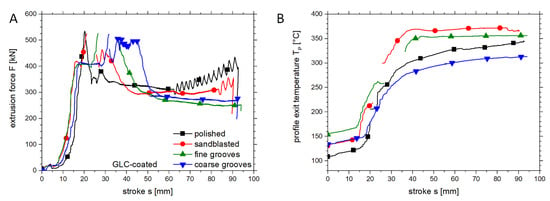
Figure 6.
Extrusion diagrams of trials No. 5–8 lubricated with graphite-like carbon (GLC): (A) load-stroke curves and (B) temperature-stroke curves.
The maximum extrusion force, quasi-steady state extrusion force, and temperature increase for all extrusion trials are shown in Figure 7. Since the maximum force of the extrusion press has been reached in the trials with GLC-coated dies, a reliable statement about the dependence of the maximum force cannot be made, but, considering only the trials with Luprit SP 19, an increasing maximum extrusion force with decreasing smoothness of topography can be observed (Figure 7A). An influence of the lubricant is only visible for the maximum extrusion force, which is higher for the GLC-coated dies. In addition, the already mentioned trend of decreasing extrusion forces in the quasi-steady state with decreasing smoothness of topography can be clearly seen in Figure 7B. To describe the profile temperature (TP) independently of the dies heating during the loading process, the difference between profile temperature at quasi-steady state (TP, ss) (s = 60 mm) and initial profile temperature (TP, ini) at the beginning of the extrusion (s = 10 mm) was chosen.
ΔTP = TP, ss − TP, ini.
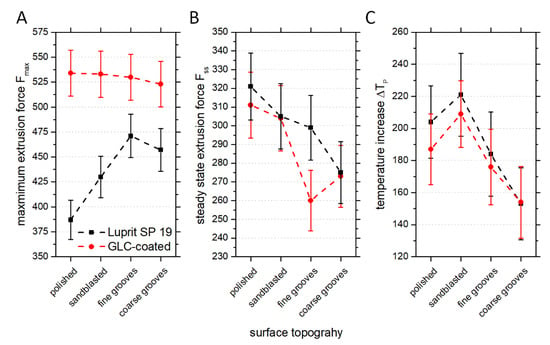
Figure 7.
Influence of the surface topography and lubricant on maximum extrusion force (A), steady state extrusion force (B), and temperature increase (C).
Figure 7C shows a higher temperature increase for the sandblasted dies and a lower temperature increase for the coarse grooves. The difference between the two lubrication conditions is very small, but the temperature tends to be lower for the trials with GLC-coated dies.
3.2. Profile Integrity
Regarding the following investigations, the extruded rods were sectioned into two and three parts, according to the integrity of the copper sleeve. For example, the rod of trial No. 1 showed good quality for the first 62 cm, but then showed recurring sleeve fractures. Hence, it was separated into two sections (front section and rear section). In contrast, at trial No. 3, sleeve fractures occurred at the beginning and at the end of the experiment. Consequently, the rod was sectioned into three pieces (front section, mid-section, and rear section). Figure 8A,B display the length of the different sections and the state of the copper sleeve. Only sections with an intact copper sleeve were subjected to further investigations.

Figure 8.
Length and integrity of the rod sections in dependence of the surface topography and lubricant: (A) Luprit SP 19 and (B) GLC-coated. Extrusion direction: ←.
3.3. Profile Surface Quality
Representative surfaces of the eight extruded composite rods are illustrated in Figure 9. The rods of trials No. 1–4 show the typical red coloring of copper and a strong gloss. They are partially covered with a thin layer of graphite. In most cases, a longitudinal elongation of this layer is visible, which is interrupted by vibration or chatter marks. No macroscopic grooves can be found. A layer of graphite can also be seen on the extrusion product of trial No. 5, next to some fine, longitudinal grooves. For trials No. 6–8, the surfaces are marked by a matt, gray coloring, and longitudinal grooves. The latter are especially deep in the rod of trial No. 8.
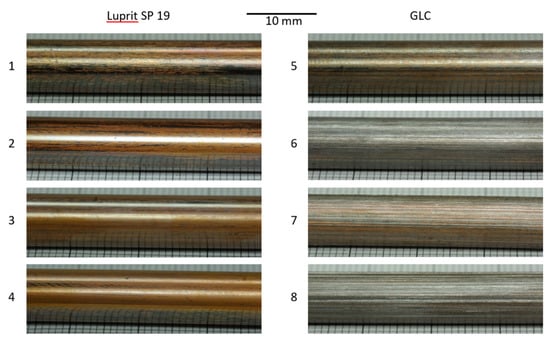
Figure 9.
Photographs of the rod surfaces of extrusion trials No. 1–8.
3.4. Equivalent Copper Cross Section
Regarding the determination of the equivalent copper cross section and its development in dependence of die cone topography and lubricant, metallographic investigations were performed. Up to six cross sections were taken from every rod section with good quality depending on the length of the intact copper sleeve. The cross sections are located 50 mm behind the beginning of the intact copper sleeve and then every 200 mm (marked as cross sections 1–6). In retrospect to the analysis and the outstanding surface quality and sleeve integrity at trial No. 2, two additional cross sections (1B and 1C) were taken 100 mm and 150 mm behind the beginning of the intact copper sleeve to achieve a higher local resolution. The cross sections were ground with SiC sandpaper, polished with 6 µm and 3 µm diamond suspension and scanned on a flatbed scanner with a resolution of 3000 dpi (Figure 10A). Subsequently, the images were processed with the free software GIMP (GNU image manipulation program) and the equivalent copper cross section was determined with the freeware ImageJ. For the analysis, the copper fraction was first isolated, as shown in Figure 10B, and then measured with the included particle analysis algorithm.

Figure 10.
Scan of a cross section (trial No. 2, section 3) (A) before and (B) after the isolation of copper and the development of the equivalent copper cross section (C) with Luprit SP 19 and (D) GLC as lubricant.
The results of this analysis are depicted in Figure 10C,D. For the trials with the lubricant Luprit SP 19 (Figure 10C), the equivalent copper cross section starts with values of 0.28–0.32, drops within 25 cm below 0.26, and stabilizes with small fluctuations of ±5% around the target value of 0.24. An influence of the surface topography is not noticeable. The trials with GLC coating (Figure 10D) partly show an increased equivalent copper cross section of up to 0.47 at the beginning and a slower reduction to the target value of 0.24. The copper excess correlates with the smoothness of surface topography. It is increased with reduced smoothness of surface topography. Furthermore, the deviation of the copper cross section in the stabilized range is up to −10%.
3.5. Interface Integrity
To characterize the quality of the interface, the cross sections were subjected to a dye penetration test. The cross sections were classified according to three interface qualities, as depicted in Figure 11. A high interface quality without any indicated gaps between copper and aluminum is shown in Figure 11A. There are gaps between copper and resin, but these are artifacts due to the shrinkage of the resin during hardening. An example for low interface quality is shown in Figure 11B, which revealed some gaps in the interface on the lower left and upper right next to the already mentioned artifacts. Figure 11C represents a very low interface quality with a large-area display of a relatively wide gap, which can be seen clearly on the lower right. A summary for all cross sections is listed in Table 3, where the interface quality is marked with “+”, “-“, and “--“ for high, low, and very low quality, respectively. “–” indicates that no data is available, for example, due to low total length of the CCA rod.
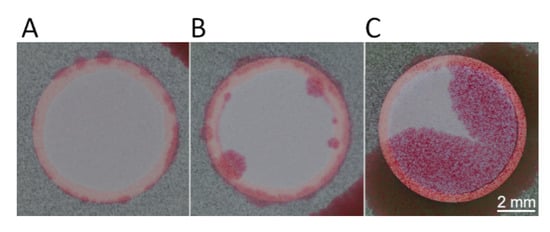
Figure 11.
Selected cross sections with different interface qualities: (A) no gaps or pores are indicated by the dye penetrant at the interface Al-Cu (trial No. 3, section 1), (B) several indicated gaps or pores at the interface Al-Cu (trial No. 2, section 1), and (C) large-area indication at the interface Al-Cu (trial No. 4, section 5).

Table 3.
Interface classification of the cross sections, according to the dye penetration test.
3.6. Contact Area between Die and Discard
The cone surfaces of all eight dies and extrusion discards are shown in Figure 12 and Figure 13. On the initially polished cone surface of trial No. 1, only a few local adhesions of graphite and a variety of longitudinal streaks can be seen. Graphite adhesions are also visible on the corresponding extrusion discard as well as the thin, longitudinally aligned graphite layer, which was also observed on the extruded rods. For trial No. 2, there is a complete layer of graphite covering the sandblasting structure of the die. In addition to a few large graphite adhesions, fine longitudinal streaks of graphite can be seen. Their imprint is visible as fine longitudinal grooves on the extrusion discard. The concentric grooves on the die cone of trial No. 3 are completely leveled with graphite. The detachment of some ring segments is clearly visible. Furthermore, the small plateaus between the concentric grooves are not completely covered with graphite but are coated with a thin layer. The missing ring segments on the die are deposited on the cone of the extrusion discard and periodically imprints caused by the plateaus are noticeable. It is the same with die and extrusion discard of trial No. 4. When comparing the dies of trials No. 1 and No. 5, there is no considerable difference visible, apart from the grey coloring of the die cone due to the GLC coating. Again, there are mainly fine, strip-like graphite adhesions. The same applies to the extrusion discard, which shows the longitudinal graphite layer, known from the profiles. In addition to the local graphite adhesions, the die of trial No. 6 shows longitudinal copper deposits. These extend over the entire length of the cone into the bearing channel. The corresponding imprints are found on the extrusion discard. In contrast to its counterpart from trial No. 3, only a few of the outer grooves of the die from trial No. 7 are partially filled with graphite. The remaining grooves are filled with copper and mostly covered with longitudinal copper deposits. The imprints of the grooves and copper deposits can be seen on the extrusion discard again. The same applies for the die and extrusion discard from trial No. 8.
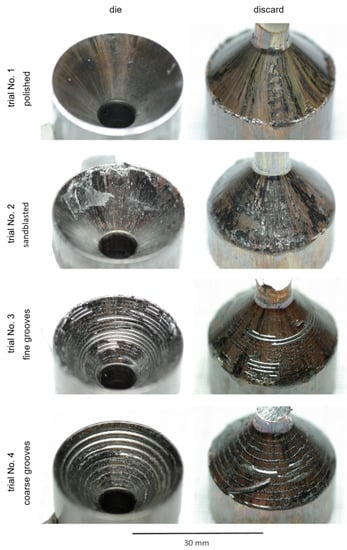
Figure 12.
Photographs of the used dies and extrusion discards of trials No. 1–4 with Luprit SP 19.
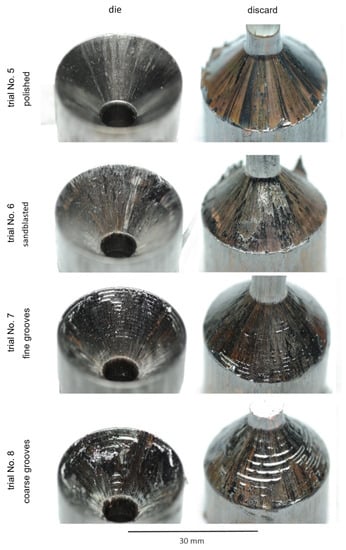
Figure 13.
Photographs of the used dies and extrusion discards of trials No. 5–8 with GLC-coating.
4. Discussion
4.1. Extrusion Trials
Indirect extrusion experiments with four different surface topographies on the die cone and two different lubrication conditions were carried out. When defining the billet geometry, two factors must be taken into account—material flow and preparation effort. For small flanging angles such as the applied 9°, only a small cross section of the copper is in contact with the die at the beginning of the process. Considering the low contact area, a high contact pressure and, consequently, intense interlocking of the copper and die cone surface is to be expected. Hence, this is disadvantageous for the material flow and, therefore, the flanging angle of 9° is classified unsuitable. Instead an angle identical to the semi die angle α is recommended. However, the disadvantage of large flanging angles, i.e., even more complex billet preparation and scrap production by machining, have to be considered when defining the billet geometry.
The investigation of the extrusion diagrams in Figure 3, Figure 4, and Figure 6 revealed oscillations and drops of the extrusion force as well as a stepwise increase of the profile exit temperature. The oscillations in the extrusion force can be explained by the recurring fracture of the copper sleeve since the number of oscillations observed in each extrusion diagram is equal to the number of sleeve fractures on the corresponding profile. Furthermore, the sleeve fractures are the cause for the stepwise increase of the temperature. Due to lacking contact between thermocouple and extruded copper during a sleeve fracture, the ambient temperature of the die is measured. Therefore, the curve stagnates until the thermocouple regains contact with the copper. In addition, the greatly slowed deformation of copper during the sleeve fracture causes significantly less heat generation. On the one hand, the deviation of the initial temperatures is caused by different residence times of the dies in the container during the loading process. On the other hand, the contact conditions between die and container vary due to wear of the container bore and, therefore, cause varying degrees of heat transfer.
Another phenomenon, only observed in the extrusion diagrams of trials No. 6–8 with the GLC-coated dies (Figure 6A), is a more or less distinctive plateau at an extrusion force of approximately 410 kN. Since the coating is very thin and does not level the topography as the Luprit SP 19 does in trials No. 2–4, the copper is pushed into the depressions of the topography and clogs them. Therefore, the copper cannot slip on the lubricant, but is sheared off. This causes higher friction and, thus, retention of the copper. As a consequence, the extrusion of a distinct full aluminum head results, as shown in Figure 14, which depicts the tips of the front-sections from trials No. 5–8 with full aluminum heads of different lengths (23–280 mm). The length of the full aluminum head correlates with the width of the observed plateaus in the extrusion force shown in Figure 6A. Thus, these plateaus are caused by solely extrusion of aluminum. Due to the smoothness of the polished die cone in trial No. 5, the GLC-coating produces reasonably good lubrication conditions and only a short full aluminum head is extruded.

Figure 14.
Tips of the front-sections from trials No. 5–8 with full aluminium heads of different lengths.
For the maximum extrusion force, an increase with reduced smoothness of topography for the tools lubricated with Luprit SP 19 can be seen in Figure 7A. An explanation for this is likely the amount of macroscopic interlocking between copper and die surface during the unsteady beginning of the extrusion process. The low roughness of the polished surface causes mainly microscopic interlocking and the material flow is unaffected, apart from the friction. Due to the asperities of the sandblasted surface, macroscopic interlocking intensifies and the material flow is slightly impaired, which causes an increase of the maximum extrusion force. The applied grooves both cause severe macroscopic interlocking and, therefore, impair the material flow even more. Consequently, the maximum extrusion force is higher. Due to the similar geometry of fine and coarse grooves, there is only a little difference in the maximum extrusion force. It is supposed that the lower number of coarse grooves causes less negative affection of the material flow and, thus, a lower maximum extrusion force. This influence of the topography on the maximum extrusion force cannot be noticed for the tools with GLC-coating since the maximum load of the extrusion machine was reached in all four trials. These significantly higher maximum extrusion forces, 110–138% compared to the use of Luprit SP 19 and depending on the surface topography, illustrate the significance of the lubrication conditions. The GLC-coating seems to be unable to generate adequate lubrication conditions for good material flow and, therefore, the interlocking of copper and die surface is even more intense during the unsteady processes at the beginning of the extrusion. However, Luprit SP 19 clearly reduces the necessary forces and, thus, counteracts the interlocking to a certain extent. Another indication for less suitable lubrication conditions with lower smoothness of topography are both delayed transition to the quasi-steady state (Figure 4A and Figure 6A) and accumulated the occurrence of the initial sleeve fractures (Figure 8). This was especially observed for the tools with fine and coarse grooves at both lubrication conditions (trials No. 3, 4, 7, and 8) as well as for the tool with sandblasted surface and GLC-coating (trial No. 6).
By comparing the quasi-steady state extrusion force in dependence on the die cone topography (Figure 7B), a decrease of the extrusion force with decreasing smoothness of topography was observed. Since the extrusion forces in the quasi-steady state are partly very similar, although the lubrication conditions are very different, other factors, such as equivalent copper cross section and temperature development, also have to be considered. The combination of surface topography and lubrication condition defines the contact conditions between copper and die surface. For the use of Luprit SP 19, the contact area of both surfaces lowers with decreasing smoothness of the topography. In trial No. 1 with the polished die cone, the contact area is the largest and, thus, the friction is the highest. In trial No. 2, the depressions of the sandblasted topography are leveled by Luprit SP 19 and, thus, the contact is limited to the asperities of the topography and the friction is reduced. The tools with grooves (trial No. 3 and 4) have an even lower contact area with copper because the grooves are also leveled with Luprit SP 19. As a consequence, the contact is limited to the plateaus between the grooves. In all cases, Luprit SP 19 also acts as a lubricant on the contact surface of copper and die and a good product surface is generated (Figure 9). The deposited graphite on the product surfaces implies a steady conveyance of lubricant away from the lubricated contact surface. This lost lubricant is replaced by the Luprit SP 19 entrained by the billets’ surface from the container. In this way, a steady supply with lubricant is facilitated. For the tools coated with GLC, the contact conditions are very different. Although the layer also acts as a lubricant, it cannot level the depressions of the topography since it was applied uniformly on the whole surface. Hence, copper is pushed into the depressions, sheared off from the flowing material, and remains in the depressions (Figure 13). High friction is caused by the interaction of sheared and flowing copper. Only by entrainment of Luprit SP 19 from the surface of the billet, the friction between sheared and flowing copper is reduced enough to accomplish a sound extrusion. The acceptable product surface quality of trial No. 5 shows the principle capability of GLC to facilitate good lubrication conditions on smooth die surfaces. However, the sandblasted surface is already too rough and an unsatisfactory product surface quality is fabricated. As mentioned before, the equivalent copper cross section and profile exit temperature or, in this case, the temperature increase must be considered as well when interpreting the quasi-steady state extrusion force. The former has a direct impact on the extrusion force due to the increase of the composite billets’ total flow stress with an increasing equivalent copper cross section. For the temperature increase, a considerable dependence on the die cone topography is noticeable and it is affected by several factors, i.e., friction, contact area of copper and die surface, initial temperature, heat introduced by the container, and heat generated by deformation. For both lubricants, the temperature increase is lower with decreasing smoothness of topography with exception of the polished surface. This effect is supposed to be caused by the lower heat generation by friction due to the decreasing contact surface of copper and die with decreasing smoothness of topography. The lower temperature increase in the case of the polished die may be caused by a different balance of heat generated by friction and dissipated into the tool. On the one hand, the large contact surface causes high friction and, thus, high heat generation. On the other hand, this heat can be dissipated very well into the tool because of the large contact surface. The effect of initial temperature on the temperature increase is a result of the non-isothermal process conditions and the temperature dependence of the heat transfer. At first, the billet is heated very quickly by the hot container as a consequence of the high initial temperature difference of approximately 300 °C. With equalization of the temperatures, the heat transfer is reduced and the temperature increase is slowed down. This is also expected to be the cause of the observed asymptotic approach to a maximum temperature. In addition, with increasing temperature, the heat generated by deformation is lowered due to lower flow stresses. Due to this and the long residence time of the billet in the container during the safety shutdowns, the curves of trial No. 6 and 7 reach a constant temperature level. The last point to be considered is the influence of sleeve fractures. As discussed before, the deformation of copper is slowed during the occurrence of sleeve fractures and less deformation heat is generated. Since this effect is cumulative, the more sleeve fractures are observed, the less temperature increase is expected. This is in accordance with the lower temperature increase (Figure 7C) and the accumulated occurrence of sleeve fractures for the trials with GLC-coated dies (Figure 8B). All these mentioned factors and their interactions influence the quasi-steady state extrusion force. Therefore, a clear identification of the main influences is not possible.
4.2. Profile Surface Quality
The inspection of the rods’ surfaces extruded with Luprit SP 19 (trials 1–4) showed consistently good results (Figure 9). For trials No. 6–8 with GLC-coating, the surface quality is just as consistent, but is impaired by circumferential grooves. Hence, no relevant influence of the surface topography can be determined. An exception is trial No. 5 with sporadic, small, longitudinal grooves. This good result in spite of the bad surfaces for the other tools with GLC-coating is likely caused by the smoothness of the polished cone surface. Due to the smooth surface and the lubrication by the GLC-coating, the copper slides well over the steel and the buildup of adhesions is prevented. In contrast to the low influence of the surface topography, a strong influence of the lubricant is observed. To explain the causes of this observation, representative macro images of die and rod of trial No. 4 and 8 are illustrated in Figure 15. On the tool lubricated with Luprit SP 19, the filled grooves close to the bearing channel are clearly visible and the red arrow marks a ring segment, which has partially separated from the groove. Regarding the completely filled lubricant reservoirs, a constant supply during the process is ensured and, thereby, a smooth rod surface is achieved. Another indication for good lubricant supply is the continuous layer of graphite on the composite rod. It is different for the GLC-coated die. The grooves are filled with copper and the cone is extensively covered with longitudinal copper adhesions, which is marked with red arrows as well. Since these adhesions reach into the bearing channel, they take part in forming the profile and leave their imprints on the rods’ surface. This phenomenon is known from aluminum processing, as die-line defect and described by Clode and Sheppard as follows. Parts of the extruded material stick to the bearing channel and build a film of adhesions. These adhesions are subjected to work hardening and die quenching and, therefore, are harder than the extruded material. The resulting ridges leave their topological appearance on the extruded material and, thus, generate grooves on the profile. The built-up film of adhesions is very stable and changes only slightly during the extrusion process [].
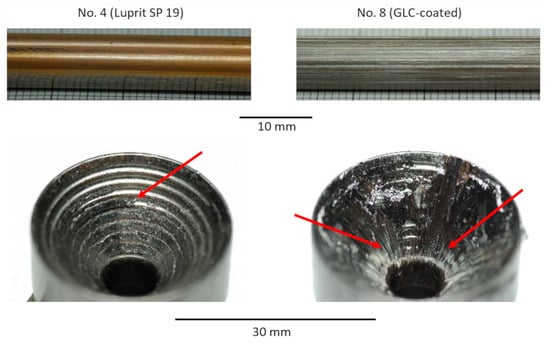
Figure 15.
Comparison of the rods’ surface quality and tools of trial No. 4 and No. 8. Red arrows mark grooves filled with graphite (Luprit SP 19) or copper (GLC-coated).
4.3. Interface Integrity
To evaluate the interface integrity between aluminum (core) and copper (sleeve), cross sections from the extruded rods were subjected to a die penetration test. Neither a significant influence of the lubrication condition, which is consistent with the similar quasi-steady state extrusion forces and profile exit temperatures, nor of the surface topography, was determined. Only both tools with coarse grooves throughout produced an interface of low quality with partly large defects. This is due to the lower temperatures and the greatly inhomogeneous material flow during the extrusion. The low temperatures restrain diffusion processes, which are responsible for the formation of an intact interface [] and the inhomogeneous material flow leads to damaging potentially formed interfaces.
4.4. Equivalent Copper Cross Section
The quantitative analysis of the equivalent copper cross section was carried out by determining the copper area fraction of cross sections via image processing. The comparison of the rods extruded with GLC-coated tools reveals strongly different excesses of the copper cross sections at the unsteady beginning of the extrusion process. Compared to the target value of the copper cross section of 0.24, the tool with coarse grooves produces an excess of 95% and the tools with fine grooves and sandblasted surface produce excesses of 85% and 50%, respectively. The only tool with a small deviation of 2% is the polished one. Since this correlation of copper excess and surface topography cannot be found in the tools lubricated with Luprit SP 19, it can be reasoned with the insufficient filling of the lubrication reservoirs and the retention of copper in dependence of the surface topography caused thereby. Besides the tool with polished surface, only the sandblasted tool accomplishes the stabilization of the copper cross section within less than 25 cm, as the sandblasted surface does not affect the flow behavior of copper as seriously as the fine or coarse grooves. For the trials with Luprit SP 19, the maximum excess is 24% and is limited to the first 25 cm of the CCA rod, which is an indicator of significantly better lubrication in contrast to the GLC coating. The superior lubrication by Luprit SP 19 reduces the interlocking of copper and surface topography at the beginning of the extrusion and, therefore, enables a quicker stabilization of material flow.
4.5. Sleeve Integrity
The lengths of all rod sections were presented in Figure 8. The total length varies due to the sleeve separations, which cause the sole extrusion of aluminum. A comparison of the integrity of the individual sections shows a correlation of sleeve integrity and lubrication condition. On the one hand, the trials with Luprit SP 19 have a lower number of defect sections and, on the other hand, these sections are shorter than their counterparts from the trials with GLC-coating. From this, it can be concluded that Luprit SP19 is much more suitable for providing appropriate lubrication. The reason for this is the leveling of asperities on the die cone and, thereby, building up lubrication reservoirs for the extrusion process. Furthermore, the trial with Luprit SP 19 and sandblasted cone surface shows no sleeve fractures at all. This is due to a particularly well-suited surface topography, which provides an excellent balance of surface roughness. While the asperities are sufficient to provide large enough lubrication reservoirs, they are small enough not to impair material flow. This is, together with the excellent copper cross section and the very good interface integrity, an indication of a particularly suitable combination of lubricant and surface topography. In contrast, all tools with GLC-coating produce a defect section at the beginning. The reason for the initial sleeve fractures is again the already mentioned unsuitable lubrication condition created by the GLC-coating, which causes interlocking of copper and the die topography. Additionally, this interlocking causes an increase in extrusion force and, therefore, triggers the safety shutdown of the extrusion machine at 525 kN. The safety shutdowns occurred multiple times at trials No. 6 and 7, but also as a singularity at trial No. 8. Given the multiple sleeve fractures cumulated at the end of trials No. 6 and 7 (Figure 8B), a correlation of those two effects is possible. Since increased residence time of the billet in the container during the safety shutdowns causes an increase of billet temperature and, therefore, an increase in the flow stress ratio of copper and aluminum. However, as the temperature quickly approaches a constant level and the sleeve fractures occur at the very end of the extrusion, a significant influence of the temperature is unlikely. Considering the occurrence of sleeve fractures at the end of trial No. 3, where no safety shutdowns were triggered and temperature has not reached a constant level, a reliable evaluation of the correlation of safety shutdowns and sleeve fractures is not possible.
5. Conclusions
In this study, the indirect extrusion of copper-clad aluminum rods applying conic dies with different die topographies and lubrication conditions was analyzed. Dies with polished and sandblasted surfaces as well as with fine and coarse grooves were tested. Additionally, the effect of a wax-graphite-based lubricant and a graphite-like carbon coating of the dies’ conic surfaces was investigated. For the combination of sandblasted die surface and the wax-graphite-based lubricant Luprit SP 19, a permanent and stable lubrication was provided throughout the extrusion. With this configuration, the best product was extruded regarding the analyzed quality factors profile integrity, profile surface quality, equivalent copper cross section, and interface integrity. A uniform material flow was observed and no sleeve fractures occurred. In contrast, the used graphite-like carbon-coating proved unsuitable due to lack of lubrication, which causes accumulated sleeve fractures and longitudinal grooves on the extruded rods. The fine and coarse grooves turned out to be too deep and entail a delay of the quasi-steady state as well as an increased incidence of sleeve fractures, especially at the beginning of the extrusion.
Author Contributions
F.G., R.N., V.S., and S.M. contributed conception and design of the study; S.K. prepared the billets and dies; F.G., R.N., V.S., and S.K. carried out the extrusion trials; S.K. performed the analyses; F.G. and V.S. helped with the interpretation of the results; S.K. wrote the first draft of the manuscript. All authors contributed to revising the manuscript, reading, and approving the submitted version.
Funding
The authors are grateful for the financial support of the Deutsche Forschungsgemeinschaft (DFG) [grant no. MU2963/14-1].
Acknowledgments
The authors are grateful to Fraunhofer Institute for Surface Engineering and Thin Film IST, where the GLC-coating was applied and Fraunhofer Institute for Reliability and Micro-integration IZM, where the topography and roughness measurements were carried out. We acknowledge support by the German Research Foundation and the Open Access Publication Fund of TU Berlin.
Conflicts of Interest
Author Felix Gensch was employed by the company INGWERK GmbH. The remaining authors declare that the research was conducted in the absence of any commercial or financial relationships that could be construed as a potential conflict of interest.
References
- Kang, C.-G.; Kwon, H.C. Finite element analysis considering fracture strain of sheath material and die lubricant in extrusion process of Al/Cu clad composites and its experimental investigation. Int. J. Mech. Sci. 2002, 44, 247–267. [Google Scholar] [CrossRef]
- Lou, J.; Xu, Y.; Zhao, S. Cold Extrusion Forming of Copper/aluminum Clad Composite. Appl. Mech. Mater. 2002, 16, 441–444. [Google Scholar] [CrossRef]
- Kang, C.G.; Jung, Y.J.; Kwon, H.C. Finite element simulation of die design for hot extrusion process of AL/Cu clad composite and its experimental investigation. J. Mater. Process. Technol. 2002, 124, 49–56. [Google Scholar] [CrossRef]
- Kazanowski, P.; Epler, M.E.; Misiolek, W.Z. Bi-metal rod extrusion—Process and product optimization. Mater. Sci. Eng. A 2004, 369, 170–180. [Google Scholar] [CrossRef]
- Haghighat, H.; Momeni-Khabisi, H. Analysis and finite element simulation of bimetallic backward rod extrusion. Aust. J. Mech. Eng. 2014, 12, 282–290. [Google Scholar] [CrossRef]
- Kwon, H.C.; Jung, T.K.; Lim, S.C.; Kim, M.S. Fabrication of Copper Clad Aluminum Wire (CCAW) by Indirect Extrusion and Drawing. Mater. Sci. Forum. 2004, 449, 317–320. [Google Scholar] [CrossRef]
- Berski, S.; Dyja, H.; Maranda, A.; Nowaczewski, J.; Banaszek, G. Analysis of quality of bimetallic rod after extrusion process. J. Mater. Process. Technol. 2006, 177, 582–586. [Google Scholar] [CrossRef]
- Sanabria, V.; Gall, S.; Gensch, F.; Nitschke, R.; Müller, S. Backward Rod Extrusion of Bimetallic Aluminum-Copper Alloys at Room Temperature. AIP Conf. Proc. 2019, 2113, 030001. [Google Scholar] [CrossRef]
- Khosravifard, A.; Ebrahimi, R. Investigation of parameters affecting interface strength in Al/Cu clad bimetal rod extrusion process. Mater. Des. 2010, 31, 493–499. [Google Scholar] [CrossRef]
- Nonferrous Metals Standards Committee. Aluminium and Aluminium Alloys—Chemical Composition and Form of Wrought Products—Part 3: Chemical Composition and Form of Products, German version EN 573-3:2019; DIN German Institute for Standardization: Berlin, Germany, 2019. [Google Scholar]
- Nonferrous Metals Standards Committee. Copper and Copper Alloys—Compendium of Compositions and Products, German version CEN/TS 13388:2015; DIN German Institute for Standardization: Berlin, Germany, 2015. [Google Scholar]
- Field, S.K.; Jarratt, M.; Teer, D.G. Tribological properties of graphite-like and diamond-like carbon coatings. Tribol. Int. 2004, 37, 949–956. [Google Scholar] [CrossRef]
- Clode, M.P.; Sheppard, T. Formation of die lines during extrusion of AA6063. Mat. Sci. Technol. 1990, 6, 755–763. [Google Scholar] [CrossRef]
- Rhee, K.Y.; Han, W.Y.; Park, H.J.; Kim, S.S. Fabrication of aluminum/copper clad composite using hot hydrostatic extrusion process and its material characteristics. Mat. Sci. Eng. A 2004, 384, 70–76. [Google Scholar] [CrossRef]
© 2020 by the authors. Licensee MDPI, Basel, Switzerland. This article is an open access article distributed under the terms and conditions of the Creative Commons Attribution (CC BY) license (http://creativecommons.org/licenses/by/4.0/).